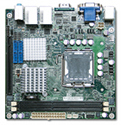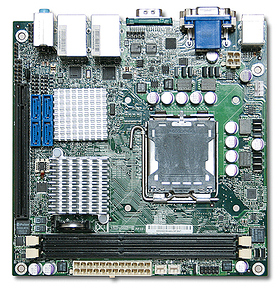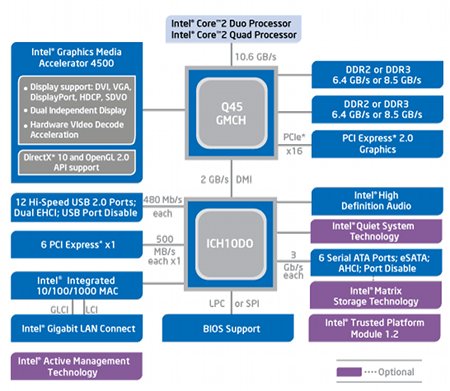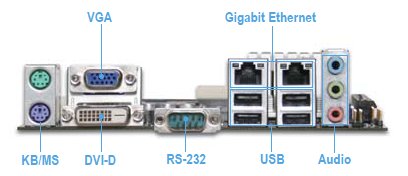Mini-ITX board features RAID, dual video outputs
Jul 30, 2009 — by LinuxDevices Staff — from the LinuxDevices Archive — 8 views Portwell has added to its collection of Mini-ITX embedded boards with a model supporting Intel Core 2 Duo or Core 2 Quad processors. The WADE-8180 includes VGA and DVI-D video outputs, has four SATA ports compatible with RAID levels 0, 1, 5, and 10, and has a PCI Express x 16 expansion slot.
Portwell has added to its collection of Mini-ITX embedded boards with a model supporting Intel Core 2 Duo or Core 2 Quad processors. The WADE-8180 includes VGA and DVI-D video outputs, has four SATA ports compatible with RAID levels 0, 1, 5, and 10, and has a PCI Express x 16 expansion slot.
Portwell says its new WADE-8180 is aimed at embedded gaming applications, plus other uses such as digital signage, surveillance, or network security. The board can drive two displays simultaneously through its VGA and DVI-D video outputs, while a third display could be connected to a graphics card installed in the system's PCI Express x 16 expansion slot, the company says.

Portwell's WADE-8180
Like a number of products we've covered recently, the WADE-8180 uses Intel's Q45 chipset (below) and ICH10DO I/O controller, which in this case is said to permit frontside bus speeds of 800MHz or 1066Mhz. The board uses DDR3 memory, and accepts up to 4GB of RAM via dual, 240-pin DIMM sockets. A motherboard socket allows installation of either Intel Core 2 Duo or Core 2 Quad processors, Portwell adds.

A block diagram of Intel's Q45 chipset
(Click to enlarge)
In addition to the PCI Express x 16 slot already mentioned, the top of the WADE-8180 includes four SATA-300 ports, which allow drives to be installed in RAID 0, 1, 5, or 10 configurations. Also on top of the board, pin headers serve up four USB 2.0 ports.

The edge of Portwell's WADE-8180
The rest of the WADE-8180's interfaces are presented via "real world" connectors on the edge of the board. As the above photo shows, these include two PS/2 ports, VGA and DVI-D outputs, an RS232 port, four USB 2.0 host ports, and two gigabit Ethernet ports. Audio connectors, meanwhile, offer mic in, line in, and line out signals.
According to Portwell, the WADE-8180 also includes a TPM (trusted platform module) and supports Intel's AMT (active management technology). The latter, among other things, allows IT to discover the presence of the board even when it is powered off, and also enables third-party software to store version numbers or policy data in non-volatile RAM for off-hours retrieval or updates, Intel says.
Jimmy Chang, American Portwell Technology's product marketing manager, stated about the WADE-8180, "The Intel Core 2 Quad processor with AMT provides application security, manageability and energy efficient performance. The Intel Q45 chipset with built-in GMA X4500 delivers a great combination of graphics performance and features to meet the expanding needs of today's business users."
Features and specifications listed by Portwell for the WADE-8180 include the following:
- Processor — Intel Core 2 Quad or Core 2 Duo (potential clock speeds not stated)
- Memory — Up to 4GB of DDR2 RAM via dual DIMM slots
- Storage — RAID 0, 1, 5, or 10 via SATA-300 ports
- Display — Supports resolutions up to 2048 x 1536 via VGA and DVI-D interfaces
- Networking — 2 x gigabit Ethernet ports
- Other I/O:
- 1 x VGA
- 1 x DVI-D
- 8 x USB 2.0 (4 via headers; 4 on edge of board)
- 2 x PS/2
- 1 x RS232
- Audio — mic in, line in, line out
- 4 x SATA-300
- Expansion — 1 x PCI Express x 16 slot
- Operating temperature — 32 to 140 deg. F (0 to 60 deg. C)
- Power requirements — n/s, but uses ATX power supply
- Dimensions — 6.7 x 6.7 inches (170 x 170mm)
Availability
Portwell did not release pricing for the WADE-8180 but said the board is available now. The device is compatible with Linux, Windows XP Embedded, Windows CE, Windows XP, and Windows Vista, according to the company.
More information on the WADE-8180 may be found on the Portwell website, here.
This article was originally published on LinuxDevices.com and has been donated to the open source community by QuinStreet Inc. Please visit LinuxToday.com for up-to-date news and articles about Linux and open source.